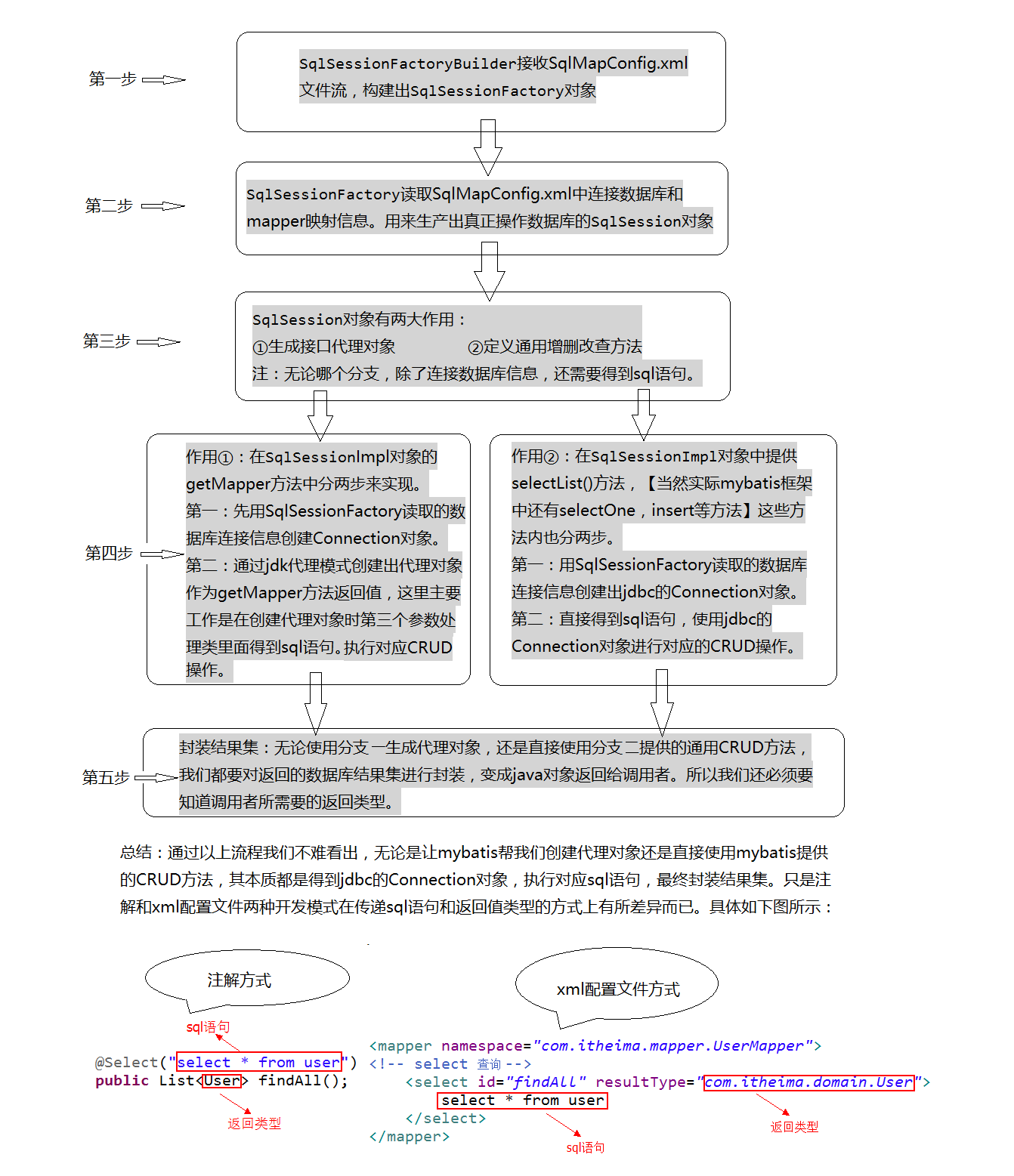第二天:mybatis基本使用
mybatis的单表crud操作
mybatis的参数和返回值
mybatis的dao编写
mybatis配置的细节
几个标签的使用
1、回顾mybatis自定义和环境搭建+完善自定义Mybatis的注解开发
2、Mybatis基于代理Dao的CRUD操作 重点内容
3、CRUD中可能遇到的问题:参数的传递以及返回值的封装
4、介绍Mybatis基于传统dao方式的使用(自己编写dao的实现类) 了解的内容
5、mybatis主配置文件中的常用标签
properties标签
typeAliases标签 ---解释Integer的写法
mappers标签的子标签:package
2、Mybatis基于代理Dao的CRUD操作 重点内容
3、CRUD中可能遇到的问题:参数的传递以及返回值的封装
4、介绍Mybatis基于传统dao方式的使用(自己编写dao的实现类) 了解的内容
5、mybatis主配置文件中的常用标签
properties标签
typeAliases标签 ---解释Integer的写法
mappers标签的子标签:package
-----------------------------------------
OGNL表达式:
Object Graphic Navigation Language
对象 图 导航 语言
它是通过对象的取值方法来获取数据。在写法上把get给省略了。
比如:我们获取用户的名称
类中的写法:user.getUsername();
OGNL表达式写法:user.username
mybatis中为什么能直接写username,而不用user.呢:
因为在parameterType中已经提供了属性所属的类,所以此时不需要写对象名
OGNL表达式:
Object Graphic Navigation Language
对象 图 导航 语言
它是通过对象的取值方法来获取数据。在写法上把get给省略了。
比如:我们获取用户的名称
类中的写法:user.getUsername();
OGNL表达式写法:user.username
mybatis中为什么能直接写username,而不用user.呢:
因为在parameterType中已经提供了属性所属的类,所以此时不需要写对象名
1.自定义mybatis开发流程图(总结)

1.2基于注解自定义mybatis的再分析


2.1 mybatis框架的crud操作
2.1.1pom文件
<?xml version="1.0" encoding="UTF-8"?> <project xmlns="http://maven.apache.org/POM/4.0.0" xmlns:xsi="http://www.w3.org/2001/XMLSchema-instance" xsi:schemaLocation="http://maven.apache.org/POM/4.0.0 http://maven.apache.org/xsd/maven-4.0.0.xsd"> <modelVersion>4.0.0</modelVersion> <groupId>com.itheima</groupId> <artifactId>day02_eesy_01mybatisCRUD</artifactId> <version>1.0-SNAPSHOT</version> <packaging>jar</packaging> <dependencies> <dependency> <groupId>org.mybatis</groupId> <artifactId>mybatis</artifactId> <version>3.4.5</version> </dependency> <dependency> <groupId>mysql</groupId> <artifactId>mysql-connector-java</artifactId> <version>5.1.6</version> </dependency> <dependency> <groupId>log4j</groupId> <artifactId>log4j</artifactId> <version>1.2.12</version> </dependency> <dependency> <groupId>junit</groupId> <artifactId>junit</artifactId> <version>4.10</version> </dependency> </dependencies> </project>
2.1.2 主配置文件
<?xml version="1.0" encoding="UTF-8"?> <!DOCTYPE configuration PUBLIC "-//mybatis.org//DTD Config 3.0//EN" "http://mybatis.org/dtd/mybatis-3-config.dtd"> <configuration> <!-- 配置properties 可以在标签内部配置连接数据库的信息。也可以通过属性引用外部配置文件信息 resource属性: 常用的 用于指定配置文件的位置,是按照类路径的写法来写,并且必须存在于类路径下。 url属性: 是要求按照Url的写法来写地址 URL:Uniform Resource Locator 统一资源定位符。它是可以唯一标识一个资源的位置。 它的写法: http://localhost:8080/mybatisserver/demo1Servlet 协议 主机 端口 URI URI:Uniform Resource Identifier 统一资源标识符。它是在应用中可以唯一定位一个资源的。 --> <properties url="file:///D:/IdeaProjects/day02_eesy_01mybatisCRUD/src/main/resources/jdbcConfig.properties"> <!-- <property name="driver" value="com.mysql.jdbc.Driver"></property> <property name="url" value="jdbc:mysql://localhost:3306/eesy_mybatis"></property> <property name="username" value="root"></property> <property name="password" value="1234"></property>--> </properties> <!--使用typeAliases配置别名,它只能配置domain中类的别名 --> <typeAliases> <!--typeAlias用于配置别名。type属性指定的是实体类全限定类名。alias属性指定别名,当指定了别名就再区分大小写 <typeAlias type="com.itheima.domain.User" alias="user"></typeAlias>--> <!-- 用于指定要配置别名的包,当指定之后,该包下的实体类都会注册别名,并且类名就是别名,不再区分大小写--> <package name="com.itheima.domain"></package> </typeAliases> <!--配置环境--> <environments default="mysql"> <!-- 配置mysql的环境--> <environment id="mysql"> <!-- 配置事务 --> <transactionManager type="JDBC"></transactionManager> <!--配置连接池--> <dataSource type="POOLED"> <property name="driver" value="${jdbc.driver}"></property> <property name="url" value="${jdbc.url}"></property> <property name="username" value="${jdbc.username}"></property> <property name="password" value="${jdbc.password}"></property> </dataSource> </environment> </environments> <!-- 配置映射文件的位置 --> <mappers> <!--<mapper resource="com/itheima/dao/IUserDao.xml"></mapper>--> <!-- package标签是用于指定dao接口所在的包,当指定了之后就不需要在写mapper以及resource或者class了 --> <package name="com.itheima.dao"></package> </mappers> </configuration>
2.1.3 映射文件
<?xml version="1.0" encoding="UTF-8"?> <!DOCTYPE mapper PUBLIC "-//mybatis.org//DTD Mapper 3.0//EN" "http://mybatis.org/dtd/mybatis-3-mapper.dtd"> <mapper namespace="com.itheima.dao.IUserDao"> <!-- 配置 查询结果的列名和实体类的属性名的对应关系 --> <resultMap id="userMap" type="uSeR"> <!-- 主键字段的对应 --> <id property="userId" column="id"></id> <!--非主键字段的对应--> <result property="userName" column="username"></result> <result property="userAddress" column="address"></result> <result property="userSex" column="sex"></result> <result property="userBirthday" column="birthday"></result> </resultMap> <!-- 查询所有 --> <select id="findAll" resultMap="userMap"> <!--select id as userId,username as userName,address as userAddress,sex as userSex,birthday as userBirthday from user;--> select * from user; </select> <!-- 保存用户 --> <insert id="saveUser" parameterType="user"> <!-- 配置插入操作后,获取插入数据的id --> <selectKey keyProperty="userId" keyColumn="id" resultType="int" order="AFTER"> select last_insert_id(); </selectKey> insert into user(username,address,sex,birthday)values(#{userName},#{userAddress},#{userSex},#{userBirthday}); </insert> <!-- 更新用户 --> <update id="updateUser" parameterType="USER"> update user set username=#{userName},address=#{userAddress},sex=#{userAex},birthday=#{userBirthday} where id=#{userId} </update> <!-- 删除用户--> <delete id="deleteUser" parameterType="java.lang.Integer"> delete from user where id = #{uid} </delete> <!-- 根据id查询用户 --> <select id="findById" parameterType="INT" resultMap="userMap"> select * from user where id = #{uid} </select> <!-- 根据名称模糊查询 --> <select id="findByName" parameterType="string" resultMap="userMap"> select * from user where username like #{name} <!-- select * from user where username like '%${value}%'--> </select> <!-- 获取用户的总记录条数 --> <select id="findTotal" resultType="int"> select count(id) from user; </select> <!-- 根据queryVo的条件查询用户 --> <select id="findUserByVo" parameterType="com.itheima.domain.QueryVo" resultMap="userMap"> select * from user where username like #{user.username} </select> </mapper>